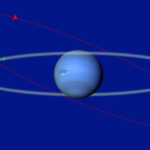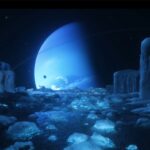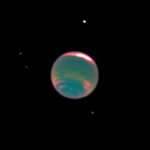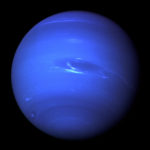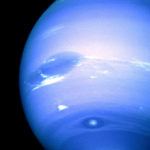With terraformed moons of its own, this has become a very populated part of the Sun solar system, and is still home to one civilization of aliens who use spherical Spaceships and life-like human disguises.
–
Table of Contents:
- Spec’s
- Moons
- History
- Images
–
Planet Info:
Like all the gas giants in the Sun solar system, Neptune has a ‘great eye’ storm, polar aurora vortexes, a ring system, and much smaller moons.
| Discovery[1] | |||||||||||||
|---|---|---|---|---|---|---|---|---|---|---|---|---|---|
| Discovered by | |||||||||||||
| Discovery date | 23 September 1846 | ||||||||||||
| Designations | |||||||||||||
| Pronunciation | /ˈnɛptjuːn/ ( |
||||||||||||
| Adjectives | Neptunian | ||||||||||||
| Orbital characteristics[3][a] | |||||||||||||
| Epoch J2000 | |||||||||||||
| Aphelion | 30.33 AU (4.54 billion km) | ||||||||||||
| Perihelion | 29.81 AU (4.46 billion km) | ||||||||||||
| 30.11 AU (4.50 billion km) | |||||||||||||
| Eccentricity | 0.009456 | ||||||||||||
|
|||||||||||||
| 367.49 days[5] | |||||||||||||
|
Average orbital speed
|
5.43 km/s[5] | ||||||||||||
| 256.228° | |||||||||||||
| Inclination | 1.767975° to ecliptic 6.43° to Sun‘s equator 0.72° to invariable plane[6] |
||||||||||||
| 131.784° | |||||||||||||
| 276.336° | |||||||||||||
| Known satellites | 14 | ||||||||||||
| Physical characteristics | |||||||||||||
|
Mean radius
|
24,622±19 km[7][b] | ||||||||||||
|
Equatorialradius
|
24,764±15 km[7][b] 3.883 Earths |
||||||||||||
|
Polar radius
|
24,341±30 km[7][b] 3.829 Earths |
||||||||||||
| Flattening | 0.0171±0.0013 | ||||||||||||
| 7.6183×109 km2[8][b] 14.98 Earths |
|||||||||||||
| Volume | 6.254×1013 km3[5][b] 57.74 Earths |
||||||||||||
| Mass | 1.02413×1026 kg[5] 17.147 Earths 5.15×10−5 Suns |
||||||||||||
|
Mean density
|
1.638 g/cm3[5][c] | ||||||||||||
| 11.15 m/s2[5][b] 1.14 g |
|||||||||||||
| 0.23[9] (estimate) | |||||||||||||
| 23.5 km/s[5][b] | |||||||||||||
|
Sidereal rotation period
|
0.6713 day[5] 16 h 6 min 36 s |
||||||||||||
|
Equatorial rotation velocity
|
2.68 km/s (9,650 km/h) | ||||||||||||
| 28.32° (to orbit)[5] | |||||||||||||
|
North pole right ascension
|
19h 57m 20s[7] 299.3° |
||||||||||||
|
North pole declination
|
42.950°[7] | ||||||||||||
| Albedo | 0.290 (bond)[10] 0.442 (geom.)[11] |
||||||||||||
|
|||||||||||||
| 7.67[12] to 8.00[12] | |||||||||||||
| 2.2–2.4″[5][13] | |||||||||||||
| Atmosphere[5] | |||||||||||||
| 19.7±0.6 km | |||||||||||||
| Composition by volume |
|
||||||||||||
Further details here.
–
Neptune’s Moons:
There are 14 publicly-acknowledged moons of this gas giant. Keeping with the deities-based naming system for all of the planets in the Sun solar system, Neptune’s moons are named after minor water deities; the moons’ names reflect the nature of the planet’s namesake deity.
–
History:
TBA
–
–
Video Player
00:00
00:00
